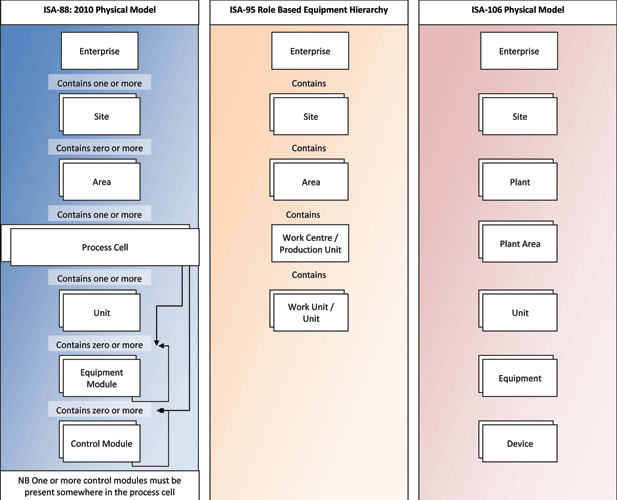

Since the approval of ANSI/ISA-88.01 – 1995 Batch Control Part 1: Models and Terminology, three additional parts of the standard have been approved and one final part remains under development. Part 1 of the standard was adopted as international standard IEC-61512 in 1997. Subsequently, parts 2 to 4 were also adopted by the IEC.
The standard continues to influence control system vendor offerings and new standards while also serving as the foundation for more advanced control and optimisation methodologies.
ANSI/ISA-88 publications
The current full suite of published ANSI/ISA-88 standards1 comprises:
* ANSI/ISA-88.00.01-2010 – Batch Control Part 1: Models and Terminology
* ANSI/ISA-88.00.02-2001 – Batch Control Part 2: Data Structures and Guidelines for Languages.
* ANSI/ISA-88.00.03-2003 – Batch Control Part 3: General and Site Recipe Models and Representation.
* ANSI/ISA-88.00.04-2006 – Batch Control Part 4: Batch Production Records. Batch Control Part 5: Implementation Models & Terminology for Modular Equipment Control, should be released shortly.
The standard is also supported by several Technical Reports:
* ISA-TR88.0.03-1996 – Possible Recipe Procedure Presentation Formats.
* ISA-TR88.00.02-2008 - Machine and Unit States: An Implementation Example of ISA-88.
* ISA-TR88.95.01-2008 - Using ISA-88 and ISA-95 Together.
As a result of terminology differences between ANSI/ISA-88 and ANSI/ISA-95.00.01-2000, Enterprise-Control System Integration Part 1: Models and Terminology, some changes were made to the former standard to more closely align the two.
Perspective
In a nutshell, ANSI/ISA-88 (S88) provides for batch control:
* A formalised terminology.
* A process model.
* A procedural control model.
* A physical model.
* A stateful perspective of control.
One of the overarching goals of the standard is the separation of the task of recipe creation and maintenance from the associated control tasks, thus allowing process staff to define the procedural aspects of batch and control engineering staff to handle the control aspects.
For example, a process engineer may require phases such as:
* Heat agitator tank T1 jacket until mix temperature reaches x°C (Tank heat).
* Hold agitator tank T1 jacket at x°C for n minutes (tank temperature hold).
... and might be responsible for defining error conditions and responses for phases:
* Tank heat - If T1 jacket fails to reach x°C in m minutes then move to phase X.
* Tank temperature hold - if T1 jacket deviates by more than y°C from setpoint x°C then move to phase Y.
* Alarm points for the measured phase parameters, etc.
Note here that each phase may involve different alarms even though the same equipment is involved in each of these two phases – we touch on the importance of this again later in this article.
The control engineer is responsible for providing the control modules that achieve these phases:
* Tank heat – set TCV set point to x°C, open steam isolation valve, start watchdog timer. etc.
* Tank temperature hold – set TCV set point to x°C, open steam isolation valve, start phase timer with n minute duration, etc.
The models of the standard combined with the stateful approach of Sequence Flow Charts (SFC) provide a framework that is well-suited to an object oriented approach to software development and offers a framework for the development of modular, maintainable, reusable control code with associated lifecycle cost benefits.
Vendor response
The success of S88 is reflected in the fact that it would be hard to find a control system vendor that does not claim to have an S88 based batch/recipe execution system in their product suite.
When vendors first took on the task of developing their S88 compliant products the consensus thinking was that phase management and resource allocation should occur in a batch server and that equipment modules downwards should execute in local DCS or PLC/PAC controllers. This batch system architecture results in significant network traffic between controllers and server and can lead to longer batch execution times introduced through the latency between a controller reporting a phase completion event and the server responding with data for the subsequent phase.
Advances in computing power and memory of front end controllers coupled with the possibility of redundant front end controllers are now spawning a new generation of batch systems where there is no separate batch server – all the phase management and coordination happens on an inter-controller and intra-controller level. Vendors of systems embracing this newer architecture, such as Honeywell with their Experion Batch Manager and Yokogawa with VP Batch, claim benefits include:
* Higher batch system availability.
* Shorter batch execution times.
* Increased equipment capacity utilisation.
* Lower lifecycle costs through reduction or elimination of investment in Microsoft operating systems.
Manufacturer response
The insightful thinking that went into S88 was influenced by many committee members from the manufacturing world and looking for real solutions to real problems. Notable amongst these were names like Air Products, Dow Chemical, Du Pont, Exxon, Hoechst, ICI, Lubrizol, Procter & Gamble Company and Smith-Kline Beecham.
These companies were looking for solutions to maintain or improve profitability in response to challenges like:
* Losing process knowledge as an ageing workforce retired and workers moved companies more often.
* The changing nature of the chemical industry from high volume, long run standardised and commoditised product to shorter runs of high value, highly customised product.
* Increasing plant complexity making it difficult for operators to manually respond to out of band manufacturing operation and abnormal conditions such as those threatening safe operation.
S88 focused on batch control, but it did not take long for owners of discrete manufacturing plant like machining, printing, filling and packaging and owners of continuous plant like petrochemical distillation plant and refineries to get the message: every process is a batch process. The continuous steady state operation phase of a ‘continuous process’ could be considered in the context of other phases such as start-up, changeover and shutdown phases. This insight helped forward thinking companies like Dow and others to benefit greatly from applying many of the philosophies included in S88 to their continuous and discrete manufacturing processes.
Standards beyond batch
Applying S88 to non-batch processes was a good start, but owners of continuous process plant recognised that there was a need to develop a standard that would formally address their circumstances.
The formation for a new standards committee, tasked with the development of standards, recommended practices and technical reports on the design and implementation of procedures for automating continuous process operations (ISA-106, Procedural Automation for Continuous Process Operations), was announced in May 2012.
The work products of this committee apply to continuous processing applications, and address topics including²:
* Models and terminology.
* Modularisation of procedural steps to foster re-use and lower TCO.
* Exception handling for abnormal situations.
* Physical, procedural, and application models.
* Process unit orientation with operational perspective.
* Recommended best practices.
* Implementation of start-up, shutdown, abnormal situations, hold states, and transition logic.
* Recommended target platform (ie, control system vs. safety system) for different types of procedures.
* Lifecycle management best practices.
* Training and certification best practices.
The first Technical Report ISA-TR-106.01 of this committee should be available by the time this article is published.
A major significant benefit of applying a stateful control philosophy to a continuous processing application is the rationalisation of alarm handling, since in any defined state only certain alarms/alarm limits will be applicable. This will contribute to the reduction or elimination of alarm flooding which often leads to poor operator decision making under abnormal situations.
The similarities in equipment hierarchy/physical models of ISA-88, ISA-95 and ISA-106 are apparent from Figure 1.

Extension and adaptation of S88 has also led to improvements in filling and packaging where the Packaging Machine Language PackML (ISA TR88.00.02-2008 Machine and Unit States: An Implementation Example of ISA-88) and Make2Pack can trace their lineage back to S88. And in somewhat of a role reversal, the PackTags of that ISA TR were influenced by thinking in ANSI/ISA-95 (S95).
A foundation for optimisation
One of the great benefits of standards is that the data structures and metadata that define different implementations of a standard across different plants and plant owners tend to be very similar. This, combined with the stateful SFC approach of S88 and S106, creates opportunities to develop additional intelligence on top of the solid foundation of these standards.
The development by Dow Chemicals of a generic batch management system for real-time operational control of batch processes based on agent-based techniques and distributed optimisation strategies using a Multi-Agent System is one such example building on S88 and S95 standards architecture3. The system is being designed to dynamically generate an optimal production schedule based on real-time plant feedback; dynamically optimise and control manufacturing operations; and to provide real-time performance analysis of plant and operators.
Another recent paper4 describes the introduction of a neural network layer between the process and basic control level in a recipe-controlled batch plant for optimisation of a batch process.
A concept of automated data mining from ERP/MES systems and from S88 Formula data structures to build timed Petri nets for optimal batch scheduling is described in a recently published book5 on computer science in manufacturing.
Where next?
A golden era. In the early days of S88 one of the oft-stated production goals was to repeatedly produce a ‘Golden Batch’ where this referred to a perfect batch, produced with least waste and least cost with the shortest possible batch duration – the stereotypical perfect batch made by the best operator or team of operators on their best day. The successful implementation of S88 based applications has largely turned this into a reality.
Applying S88, and in future S106, will assist owners in implementing the equivalent of Golden Start-ups, Golden Grade changes, Golden Shutdowns, Golden Changeovers and golden responses to abnormal conditions through the capture and implementation of procedural best practices.
Zero day production release
As regulation in the food, pharmaceutical and even chemical industries becomes ever more onerous the next challenge for producers is ‘Zero Day Production Release’ where all batch records can be completed and validated and all release flags cleared on the same day that manufacture of the batch or product is completed. S88, S95 and S106 can all contribute toward this goal.
References
1. ISA, ISA88, Batch Control Systems resources; http://tinyurl.com/barovgs
2. ISA, ISA106, Procedural Automation for Continuous Process Operations; http://tinyurl.com/bfn8n8r
3. The Dow Chemical Company, Addressing the Operational Challenges in the Manufacture of Advanced Materials and Performance Products; http://tinyurl.com/bgqbnee
4. Pliva Croatia, Optimisation of Recipe Based Batch Control Systems Using Neural Networks; http://tinyurl.com/bdyrt5t
5. nTech, Petri Nets - Manufacturing and Computer Science ISBN 978-953-51-0700-2 By Dejan Gradišar and Gašper Mušič; http://dx.doi.org/10.5772/48467
About the author

Andrew Ashton has electrical, mechanical and business qualifications and has been active in automation and process control since the early 1980s. Since 1991 he has headed up a company that has developed formulation management systems for the food, pharmaceutical and chemical manufacturing industries and manufacturing solutions involving the integration of various communication technologies and databases. Developed systems address issues around traceability, systems integration, manufacturing efficiency and effectiveness. Andrew is a contributing editor for SA Instrumentation & Control.
| Tel: | +27 31 764 0593 |
| Email: | [email protected] |
| www: | www.technews.co.za |
| Articles: | More information and articles about Technews Publishing (SA Instrumentation & Control) |
© Technews Publishing (Pty) Ltd | All Rights Reserved